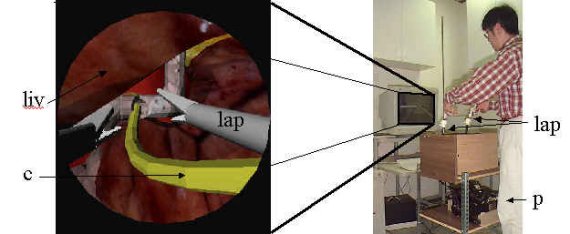
 |
|||||||
Laparoscopic Surgery Simulator |

We have developed fast algorithms for graphical rendering of the appearance and haptic rendering of reaction forces arising from tool-tissue interactions during surgical simulations. Our approach combines a finite element model and a particle model to simulate the flexible dynamics of ducts and the catheter respectively. The interactions between the forceps and the ducts as well as the catheter were simulated using the ray-based haptic interaction technique where the laparoscopic forceps were modeled as connected line segments. In this implementation two Phantoms provide haptic feedback through laproscopic instruments (lap). Surgeons feel realistic forces when their instruments encounter viscoelastic virtual organs. Practice with the simulator may improve a surgeonís ability to insert a catheter (c) during removal of the gall bladder, without damaging soft tissues like the liver (liv). Basdogan C, Ho C-H, Srinivasan MA, "Virtual environments in medical training: Graphical and haptic simulation of laparoscopic common bile duct exploration," IEEE/ASME Transactions on Mechatronics, 2001. Basdogan, C, Ho C-H, Srinivasan, MA, and Slater M, "An experimental study on the role of touch in shared virtual environments," ACM Transactions on Computer-Human Interactions. 7(4): 443-460 (2000). Ho, C-H. Computer Haptics: Rendering Techniques for Force Feedback in Virtual Environments. Ph.D. diss., Dept. of Mechanical Engineering, MIT, 2000. Ho C-H, Basdogan C, Srinivasan MA, Ray-based haptic rendering: force and torque interactions between a line probe and 3D objects in virtual environments, International Journal of Robotics Research, Vol. 19, No. 7, pp. 668-683, 2000. Basdogan C, Ho C-H, and Srinivasan MA, Simulation of tissue cutting and bleeding for laparoscopic surgery using auxiliary surfaces, Medicine Meets Virtual Reality Conference 7, San Francisco, CA., January, 1999. Ho C-H, Basdogan C, and Srinivasan MA, Efficient point-based rendering techniques for haptic display of virtual objects, Presence, Vol. 8, No. 5, pp. 477-491, 1999. Basdogan C, Ho C-H, Srinivasan MA, Small SD, Dawson, SL, Force interactions in laparoscopic simulations: haptic rendering of soft tissues, Medicine Meets Virtual Reality Conference 6, San Diego, CA., January, 1998. Basdogan C, Ho C-H, Slater M, and Srinivasan MA, The role of haptic communication in shared virtual environments, Proceedings of the Third PHANToM User's Group Workshop, October, 1998. Basdogan C, Ho C-H, and Srinivasan MA, A ray-based haptic rendering technique for displaying shape and texture of 3D objects in virtual environments, DSC-Vol. 61, Proceedings of the ASME Dynamic Systems and Control Division, Ed. G. Rizzoni, pp. 77-84, ASME, 1997. Ho C-H, Basdogan C, and Srinivasan MA, Haptic rendering: Point- and ray-based interactions, Proceedings of the Second PHANToM User's Group Workshop, October, 1997.
|
| Last Updated: May 8, 2002 1:45 PM | Comments: David Schloerb |